Propagate Sansevieria (Snake Plant): 3 Easy Ways!
How to propagate Sansevieria ( aka Snake Plant) in water or in soil easily, by leaf cuttings or division of rhizomes. Pros & cons of 3 best rooting methods!
Sansevierias have many names: Snake Plant, Bowstring Hemp Plant, Mother In Law Tongue, or Devil’s Tongue. They are some of the easiest and most beautiful plants to grow, see Snake plant care tips here. Sansevieria plants are great for indoors and mild climate outdoors.
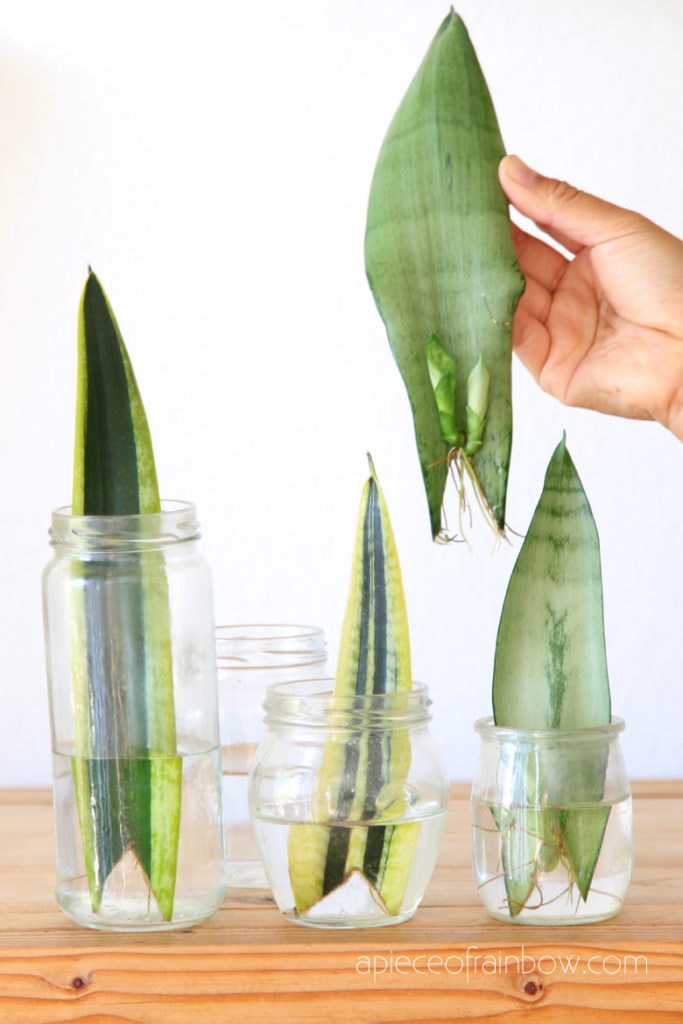
They are also incredibly easy to propagate, which means you can multiply your beautiful Sansevieria plants for your home and as gifts to share with friends!
Let’s look at how to propagate Sansevieria, and compare the pros and cons of 3 different propagation methods: by leaf cuttings in water, by leaf cuttings in soil, and by division of rhizomes.
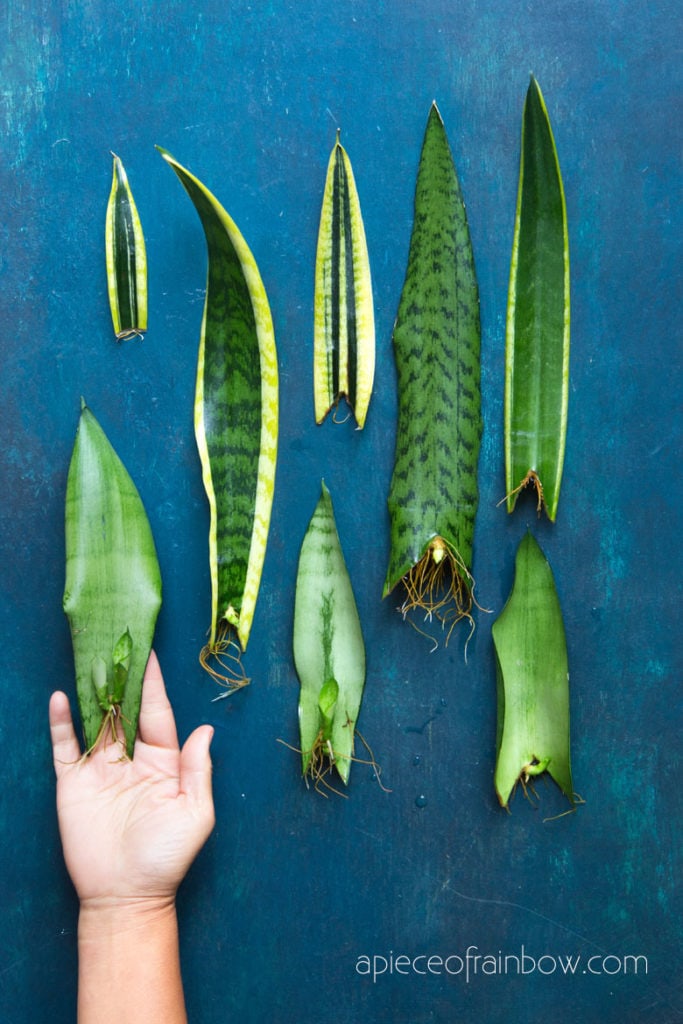
*Some resources in article are affiliate links. Full disclosure here.
Sansevieria / Snake Plant propagation basics:
Keep snake plant cuttings and plants in bright light, but out of direct sunlight. Temperature should be above 45°F, best temperature range is between 65°F and 90°F .
This is actually very similar to the propagation of Fiddle Leaf Fig, another favorite indoor plant. Tutorial here!
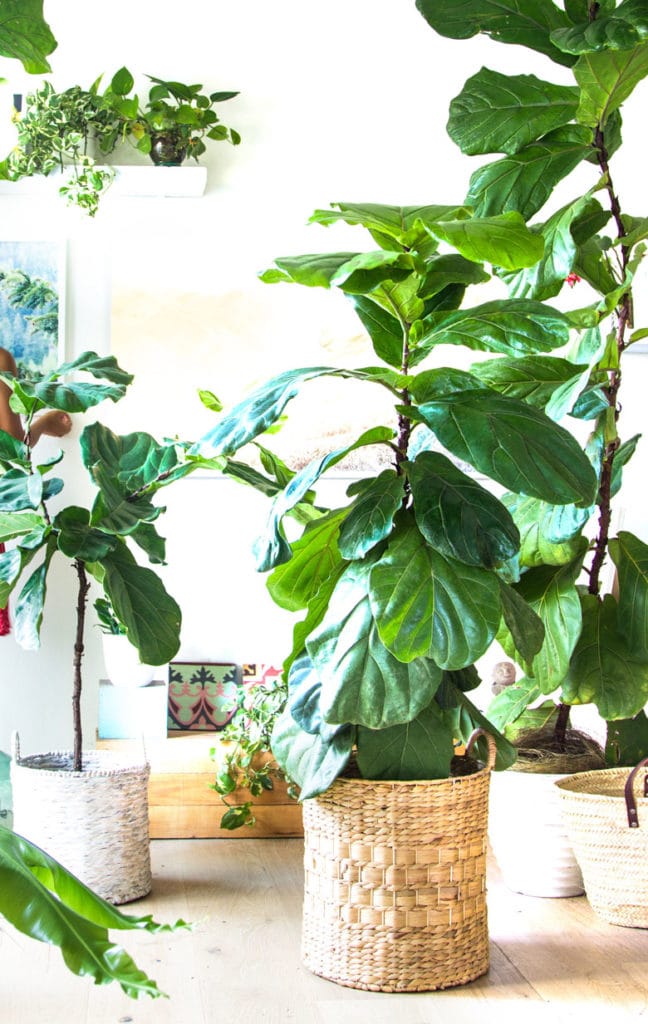
How to propagate Sansevieria leaf cuttings in water.
Water propagation is easy and fast. Remember to keep the cuttings in a bright spot with indirect light.

Cut off a healthy Snake plant leaf near its base. Make a notched upside down V cut at the bottom, and let the cut end dry for 2-5 days. The V cut will lift up the cuttings, and in addition to the drying, will make the new leaf cuttings less prone to rotting. Place the leaf in a clean jar of water.
The water level should be slightly above the V cut end. Because root will grow from the cut tissue, this technique helps to lift up most of the cut surface so roots have room to grow.
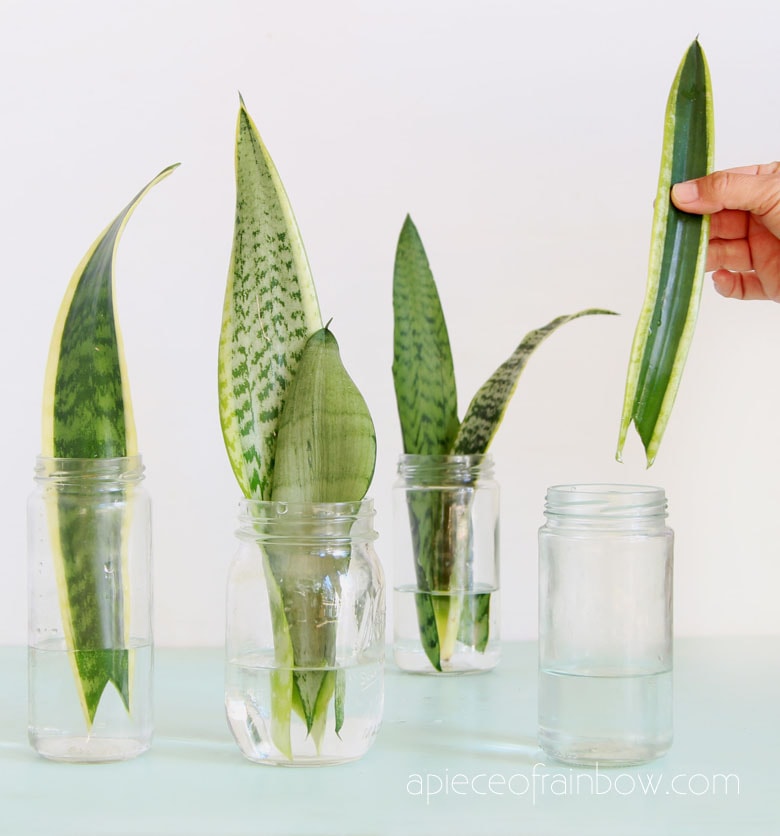
After about 3 to 5 weeks, you will see roots growing from the bottom of the leaf cuttings. In another 2 to 3 weeks, tiny pups will start growing. You can transplant the rooted cuttings in soil or just let them keep growing in water.
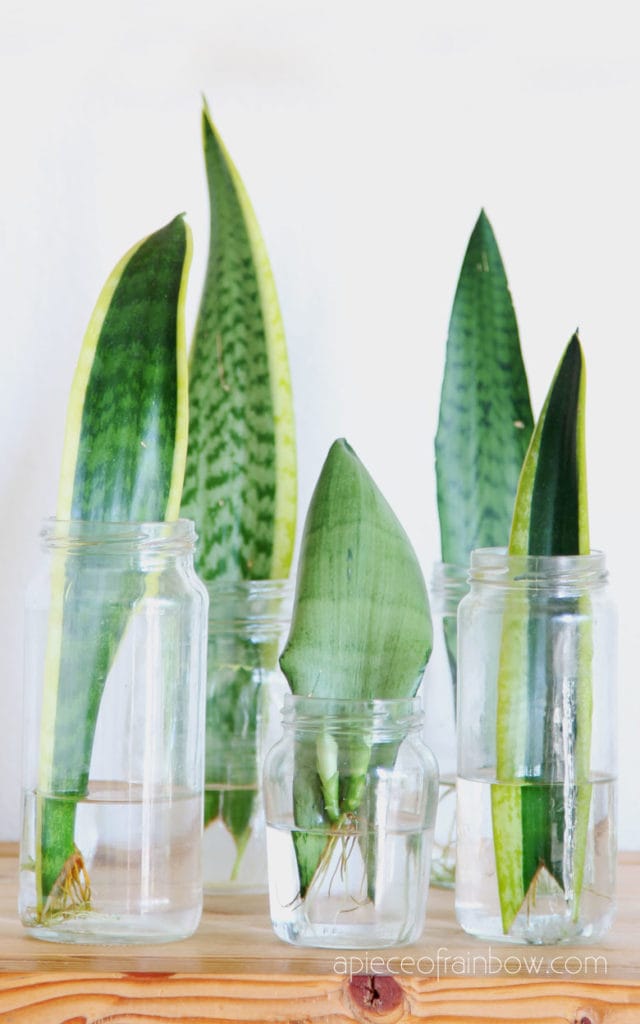
Pros of propagating Snake Plants in water:
This method is super easy. It is really fun to watch roots and pups grow from the cuttings.
If you like to grow plants in water, you will love propagating and growing Sansevierias in water. You can just keep them in water, which is my favorite way to grow certain houseplants!
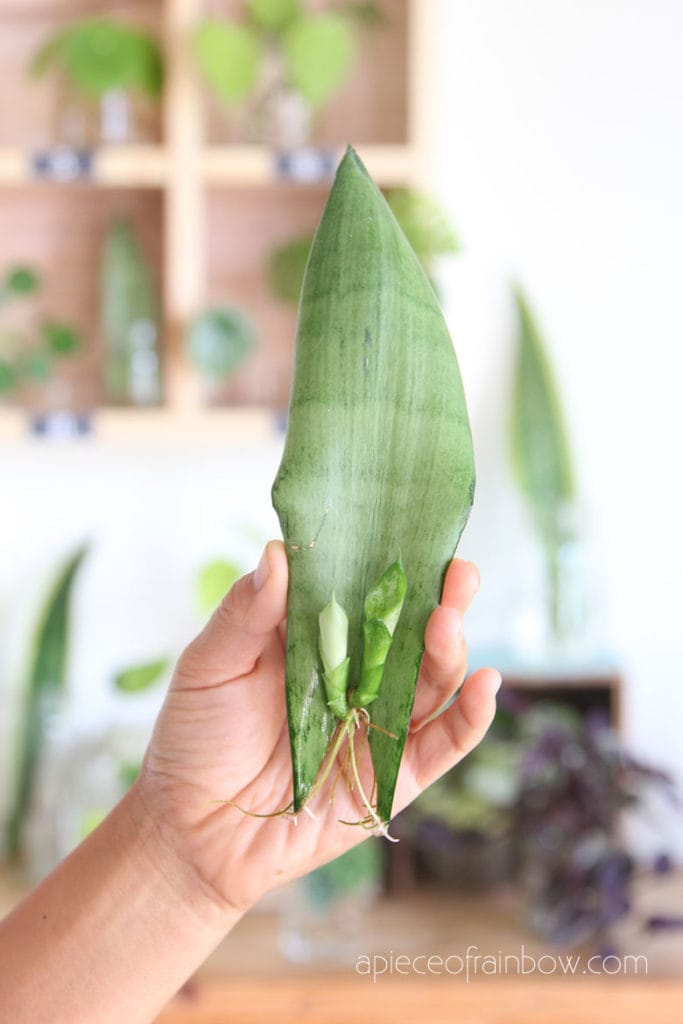
Cons:
Many showy variegated snake plant varieties such as Sansevieria “Moonshine” with dark margins, or Sansevieria “Laurentii” or “Gold Flame” with yellow stripes etc, will not keep the variegation of the mother plants. The plant babies will most likely revert to the common green Sansevieria and lose the color margins when propagated from single leaf cuttings.
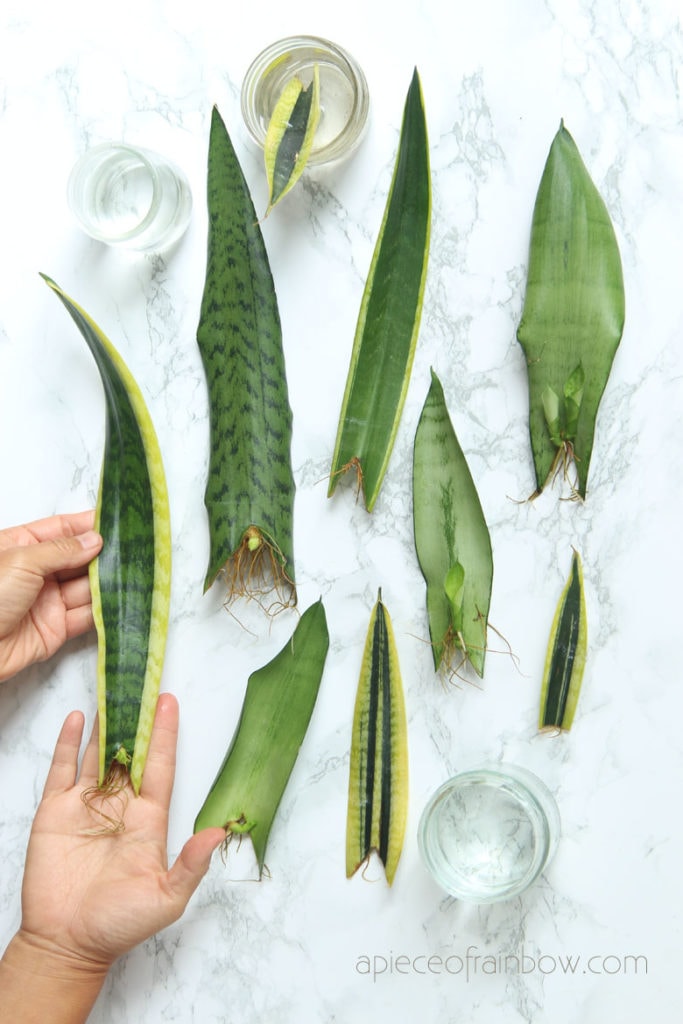
If you want to keep the unique patterns of the original variety, you will need to use method number 3: propagate by division.
You may also love: How to grow indoor plants easily in water!
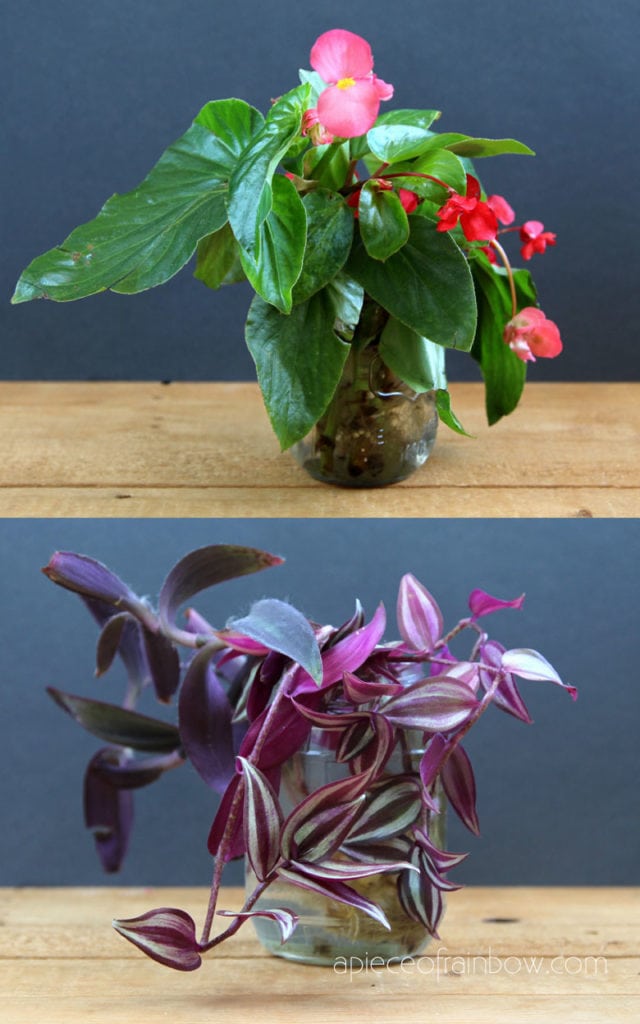
How to propagate Sansevieria leaf cuttings in soil.
This process is very similar to propagating succulents. Cut off a healthy leaf near the base of a snake plant, let the cut surface dry and heal for 2-5 days.
Plant the cuttings in potting soil that contain perlite for good drainage and air flow. No need to use root hormone. Keep out of direct sunlight, water well and let drain.
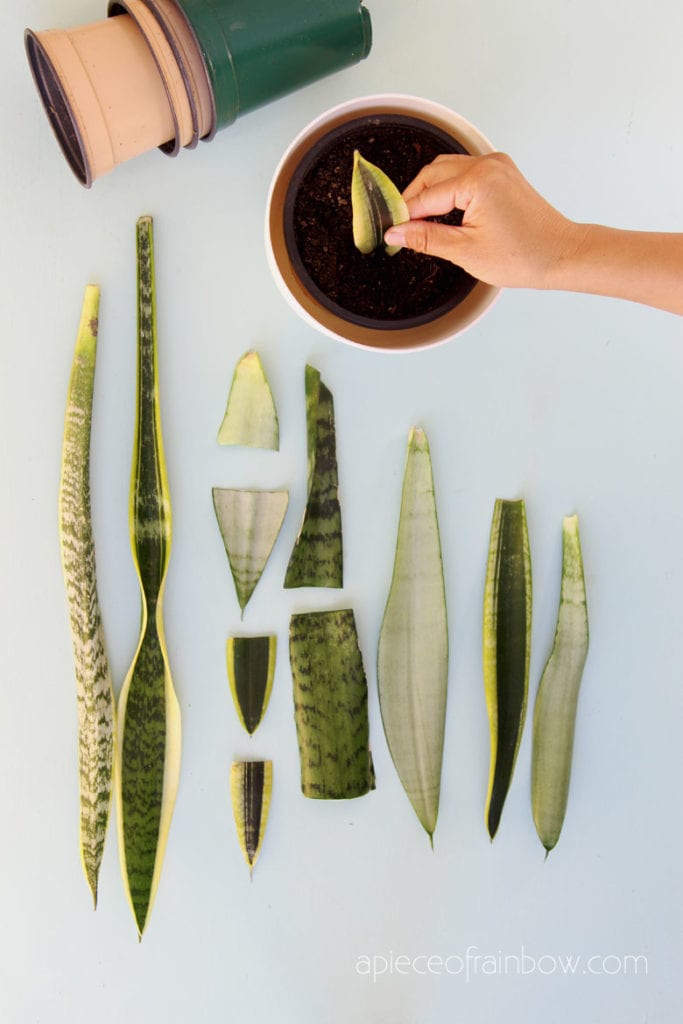
Don’t let the soil get too dry or too wet. Cuttings can die from root rot in soggy soil. Check on the soil once every one to two weeks and water if the top 2″ of soil feels dry below the surface.
Like the cuttings in water, these leaf cuttings will also root and grow pups, which will become new plants. They take only a bit longer to root than the cuttings in water.
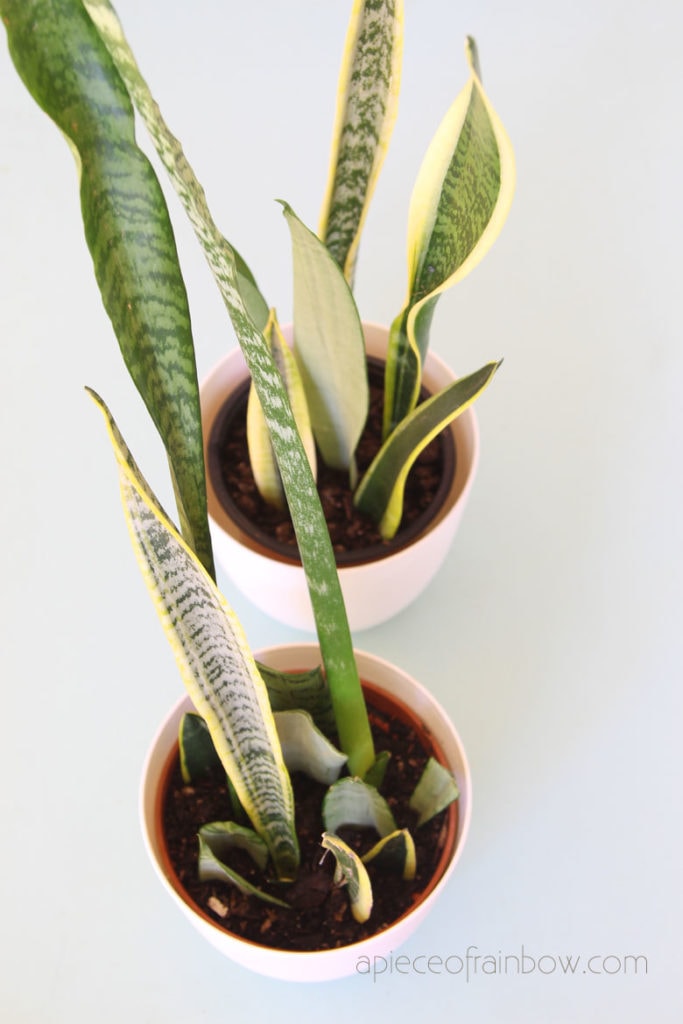
Pros:
This is a one step method. If you place several cuttings in one pot, you can have an instant plant! I like to mix different varieties in a pot. They look like living sculptures. 🙂
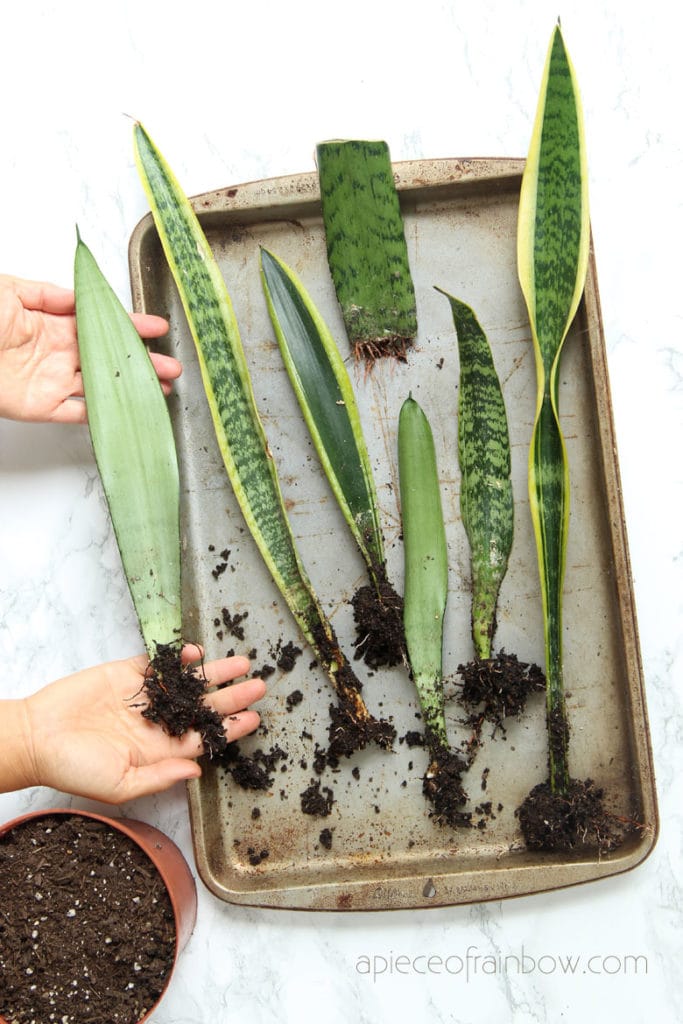
Cons:
Same as propagating leaf cuttings in water, the cuttings in soil may not grow true to the original plants if they have variegated margins or stripes.
How to propagate Snake Plant by division.
Division, in horticulture and gardening, is a method of plant propagation, where the root clump of a plant is broken up into two or more parts. Both the root and crown of each part is kept intact.
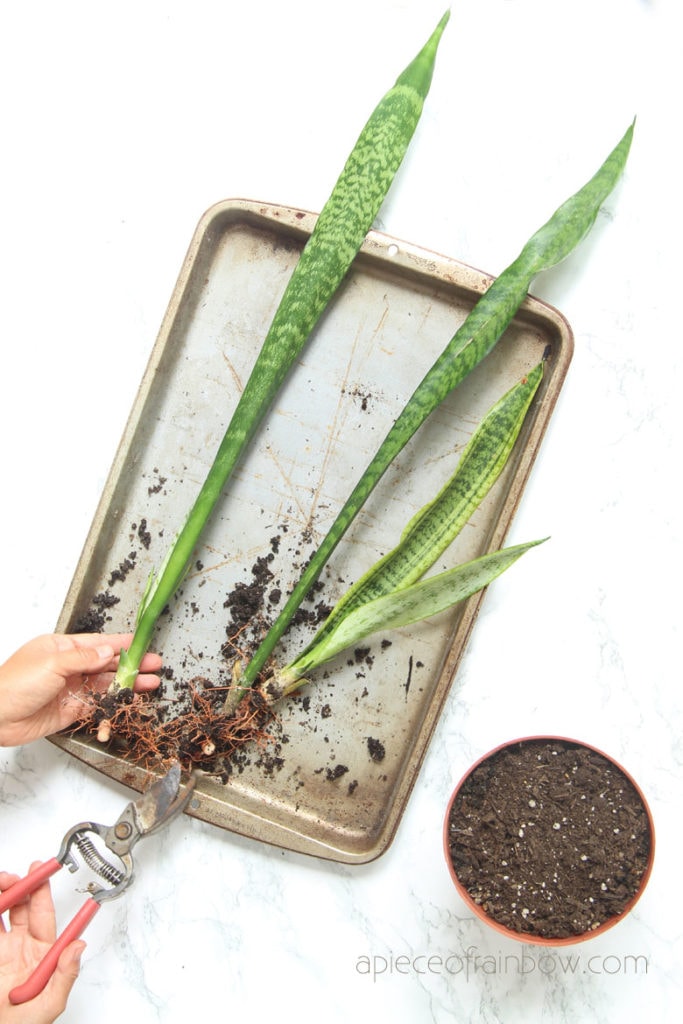
Take your plant out of the pot, or dig up a clump from the soil. Use clean and sharp knife or scissors to divide the root clump of the mother plants. Each division should have roots and some leafy top or pups attached.
Plant the divided new snake plants in their new pots with well draining potting mix such as succulent soil, or directly in the garden in warm climates. This method creates more room for new growth as your plant multiplies.
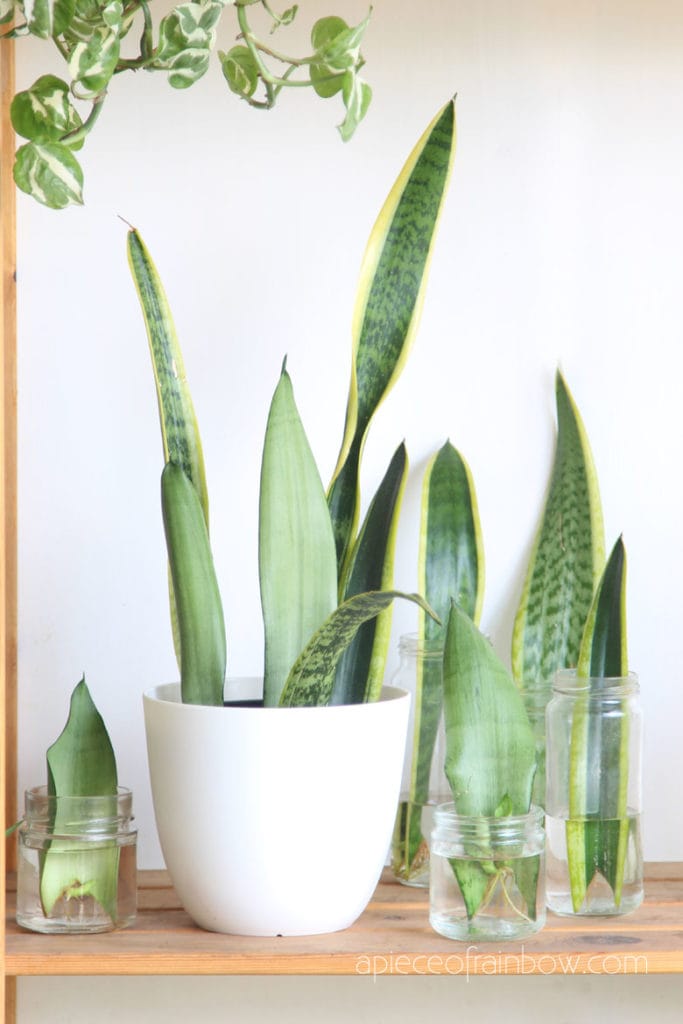
Pros:
This is the method to use if you want the Sansevieria plant to be exactly like the parent plant, the only 100% successful way to multiply those varieties with colorful margins.
Cons:
You will need a bigger plant in order to divide it.
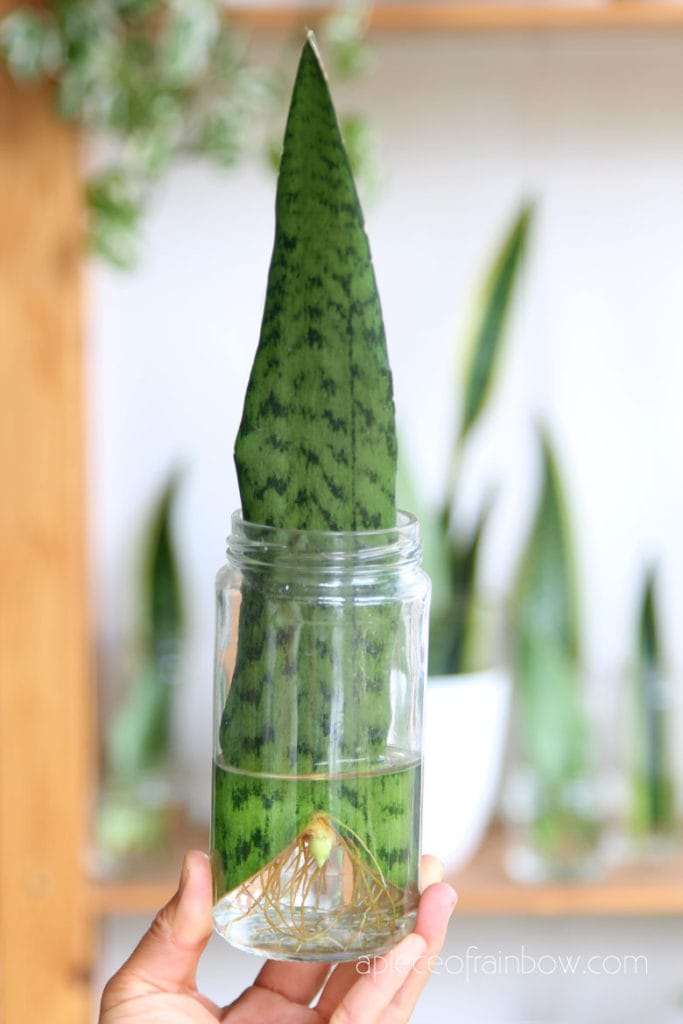
Now that you propagated Sansevierias, check out these tips on how to grow healthy Snake Plants easily! Happy growing! See you next week!

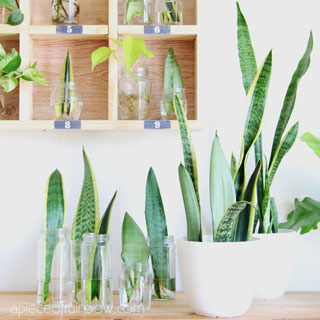




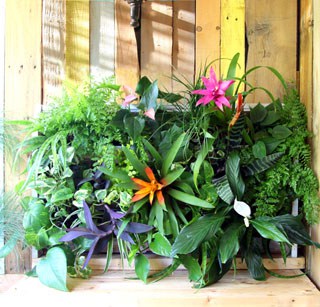

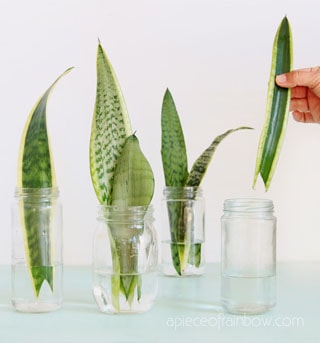







My snake plant cutting did very good in water. It rooted quickly, but still no pups, and it has been sitting like this for a few months. Any suggestions?
I have two very large snake plants, I have not tried procreating them yet but since I saw your blog and learned about the V cut I think I’m going to try it because I have several good healthy long. They are a backdrop for my other lower Bush plants. They look like a tapestry with all of my plants thank you so much.. LOL from a new plant mama
hi Donna, they are super easy and they make great gifts for other plant mamas! 🙂
Hi I brought some snake leaves back from holiday and put them in a glass vase in water I did not know that I should cut a V shape into the bottom of the leaf they was cut at a slant they have rooted and look healthy, but will need a while longer to get longer roots, can I still transplant them into soil?
hi christine! yes 🙂 the v cut is just to improve success rate. yours already have roots so you can definitely plant them 🙂
Thanks for sharing this helpful propagate Sansevieria leaf cuttings in water post its very informative. Actually, the Sansevieria is called虎皮蘭 in Chinese.
I have a question. What is the first indication that the water method isnt working and the clippings are rotting? Mine dried and healed for 5 days and I put them in water and it looks like the v cut is getting water logged and the water is getting cloudy. It’s only been 1 day in the water. Should I start over again immediately?
hi! if you have multiple cuttings, maybe try some in water and some in soil. i have had this problem only once before, and it was because the cuttings weren’t healthy.
thanks for sharing tips for propagating plants. So helpful.
Thanks for the detailed instructions. I opted to plant cuttings directly back into the plant I took them from, to increase the density of it. The cuttings took root, but it’s been a year now and still no pups. The mother plant has produced new growth and is healthy. Any tips on how to spur the cuttings along? Thanks!
hi Colleen! some snake plants can take longer to grow pups. warm weather and bright light can help! 🙂
Hey! Im really new to plants as it was a gift and I overwatered it. Well that led to me repotting it and I accidentally broke, so now there are two parts, 2 healthy leaves but with slightly wet base and the roots. If I cut up those leaves in a v shape and put it in the soil, will they grow the roots?
Also it is pretty humid due to monsoon season so I don’t know if I will be able to dry out the leaves.
Please help me it’s something reaply important for me
hi! yes they should grow! just keep the soil in the pot slightly damp for the next few weeks, they should grow roots. if the original plant looks ok, i would keep one leaf on it, and not over-water, it may recover! 🙂
Hi my problem is I have cuttings of a snake plant and I have put it in a plastic cup but I didn’t know you had to cut it in a v and they started to get mushy could I still cut it in a V and put it back in water was left of the plant and will it route thank you so much
hi! yes you can do that! i would cut off any soft part, and let the cut dry for a couple of days then put in water to root. 🙂
Hey there
Justneed a bit of help, I have a potted healthy snake plant which fell from my hand and rolled on its side. Most leaves are intact but it broke from base so only has very minimal roots attached. Roots part of it along with one leaf seperated. What should I do, I’m so upset at myself and need help in saving the plant
hi! i would treat it like 2 plants. the root part of it should have ne growth soon, and you can root the part that broke off in some soil. new roots will grow in a few weeks! 🙂
Hi, I have white growth on the soil of my Snake plant , what do you suggest I do….the plant looks healthy enough. Thank you
Hi there –
A friend of mine recently passed away and I have some of the cuttings from her plant rooting in water. I have cut the “V” shapes in each of the leaves and I assume in a week or two I should begin to see some new roots.
When is it safe to plant them into a pot and should I use a sand mix (as for a succulent) at that point or could I just keep them in a clear jar that I add some glass globs to the bottom for stability?
Lastly, at any point do I need to fertilize with a plant food? Thanks.
hi Pattie! if you want them to grow faster, you can plant them in soil anytime, and that way you can always make more cuttings to just grow in water for fun. i just use regular potting soil and rarely fertilize them, but you can mix in some slow release fertilizer once every couple of months! 🙂
Silly question perhaps, but how come these plants seem highly intolerant of overwatering when growing normally, yet seem perfectly happy growing in a glass of water when propagating?! Very curious…
hi Gavin! that’s a great question! i often wonder about it too! 🙂 i think the reason is that when they are in soggy soil, the bacteria etc can cause rotting when there’s lack of oxgen. but in clean water, plants are ok, kind of like hydroponics, maybe?
Hi.
I propagated a leaf cutting. Made sure all pieces were right side up and put them in water Dec 3rd. I change the water once a week and have it near a window with no direct Sun. However, I see no sign of roots. Any tips???
hi liz, it can be slow if the temperature is cooler near the window. as long as they don’t rot, roots will grow soon! 🙂
I divided mine but most of them have died. There’s one w tiny roots that has been in the dirt for weeks but not doing well. Can I put it in water to help develop roots?
hi rita! i would put the one in soil in a warm place and let it grow a bit more before cutting it. summer would be a better time than winter to do so! 🙂
So much useful information – thanks a bunch!
happy planting! thank you Brenda! 🙂
I found a bunch of really long leaves of a snake plant by the recycle dumpster one day. I think they neglected the plant and didn’t water it. Some have roots some don’t. Some leaves are around 4 feet long! I hope I can save most of them. No pot or soil just leaves. I hate tossing any plant unless it’s completely dead. Fingers and green thumbs crossed. 😁
they are tough plants, i think you will be able to save quite a few of them! 🙂
Hi. I’ve had the mushy problem too. Will try again. So let them sort of dry out with the v cut. Then rooting hormone? Then in water? Or in dirt? Great post. Thank you.
hi Joy! you can let the V cut dry out for a few days to a week, which can help. dirt is definitely less prone to rotting. however, i wonder if it’s due to temperature? we had no problems, and our indoor temperature is rarely below 60. 🙂
Hi I. Never knew about the v cut.
One of my stems on my plant came out I put the stem in water and did not do the V cut.
I am seeing small white roots coming out.
Can I plant it this way and will it grow?
yes you can plant it! 🙂 the V cut is just helpful when the cuttings are in water to reduce the chance of rotting!
Hi! I love these tips! Thanks for sharing this useful propagate Sansevieria leaf cuttings in the water post. All the details you described in your post about leaf cutting were very useful to me.
Hi! I love these tips! I have 4 cuttings that I placed in water after letting their cuts dry for 2 days. (I cut straight across and not in a v) they have thick roots about 1” long but no pups yet and it’s been about 5 months, should I move them to soil? I don’t want to be impatient but it’s been so long! Thank you!
hi Hayley! yes i would move them to soil. 🙂 they will grow pups in soil too!
Hi, I have one snake plant that’s almost 40 years old (various methods of propagation). It’s obviously healthy, but can you tell me how long the thing will bloom? Every summer it shoots of the most beautiful flower stalks (my mom compared them to fireworks) – that smell HORRENDOUS! The sap is a sticky consistency with a sickly sweet, rotten odor. Is there a time limit on blooming, or a way to stop it? We thought it might be light related, and moved it out of strong sunlight – but nope, sometime between June and August the kitchen smells like something died and started to rot. The flowers are worth seeing, but sometimes not at the cost of the gagging when you miss a stalk. Any tips (even to minimize the “fragrance”)?
hi Anne Marie! it must be certain species that smell so bad! some snake plant flowers smell nice! 🙂 you can cut off the flower stem as soon as it comes up to prevent the flowering.
Hi
I love plants and want to grow some. We get very little sunlight in the place I live. Heard about snake plant and will try with water. Is it ok about less light for the plant.
hi Rupa! yes snake plants can tolerate low light better than a lot of other indoor plants! 🙂
I have a ROUND leaf coming from the base of my snake plant! What??????
hi Lyn! sometimes the new leaf will look round at the beginning, but will grow longer in a few weeks! 🙂
Hi, Ananda,
Thanks so much for the clear instructions which I’ve followed. HOWEVER, my sansevieria cuttings keep rotting in water. This has happened after a week in the water. I’ve had to cut the rotted portion and try again. After the third try, I started changing the water every 3 days instead of every week. Please help! My cuttings are getting shorter and shorter. I’m into my fifth attempt. Thanks, Lucile
Hi Lucile! If you let the cut piece dry for 3-5 days, and keep the jar in a warm place but no direct sun, it may help. Make the v-cut which minimizes the area that touches the bottom of the jar will also help to prevent rotting.
Thank you.
Hello there, when I had cut one of the snake plant leaves I had cut it the just straight but in 4 cuts. Most post I have seen shows that. It’s been a week and a half propagation started. I’ll take one out and cut the V to see which one will propagate first.
Good luck Jo! 🙂 the v-cut minimizes the area that touches the bottom of the jar, which help to prevent rotting. Feel free to update here on your experiences with different cuts!
Superb planting
Hi Ananda. Is it normal for the original cutting to die after the new leaves appeared?
Hi Eve! Yes that can happen sometimes. The new leaves will grow into a plant. 🙂
You mentioned to let cuts dry before propagating in soil. Do the cuts need to dry before rooting them in water?
hi Sue, yes it also helps when rooting in water! 🙂
It’s been 8 weeks since I put my snake cuttings in water to propagate. 3 of the 4 cuttings have tiny little roots coming out, but no pups yet. I was changing out the water weekly even though it’s been clear. Is there any way to speed up this process? Your post says 3-5 for rotting, and another 2 before pups start forming? Thanks for these great articles!
hi Mani! i find some varieties send out pups sooner, but yes some had pups 2 weeks after rooting! not sure of ways to speed this up. 🙂
Thanks for sharing this helpful propagate Sansevieria leaf cuttings in water post its very informative. All details you describe in your blog post about leaf cuttings is very informative for me.
Awesome post. I’m curious, can you make multiple cuttings from one leaf? Iv tried this but always find the top roots fastest and the middle cuts seem to rot. I wasn’t sure if it’s possible or what’s going on. Also I have never seen the V cut before but I’m going to try that. How did you come to make that cut ?
Thank you in advance
-Elisa
hi Elisa! i have not tried multiple cuttings from one leaf but have seen some people doing t successfully. i saw the V cuts in some photos before, it really helps with rotting. problems. 🙂
Hello. I would like to ask if it is possible for a black gold sansevieria to grow a shoot that is not the same pattern. I’ve had this one-leaf black gold and when the shoot grew, it has the regular snake plant pattern instead. I hope someone can reply. Thanks!
yes, 90% of the time, the special varieties will revert to the common green kind of sansevieria! it’s a bummer. i did have a moonshine cutting that gave 1 moonshine nd 1 regular pup at the same time! 🙂
This is so helpful. I will definitely give this a try.
Could you also give insights on propagating a cactus plant pls. Kind regards.
Prim.
hi! most cactus will root super easily from a side shoot. soil method only, just don’t let the soil get too dry, and no soggy soil. 🙂
Hello! I am trying to propagate my snake plant in water but the ends in water keep getting mushy. Is this normal? I left the cut leaf out for 2 days to callus over. I put 2-3 cuttings in each glass with 1-2 inches of water. Im changing the water if it looks cloudy. Help!
hi! did you make the V shape cut? 🙂
x
Thank you………..that answers my question! Am off to give it all a try. Happy Spring…..soon!
I am excited to have come across this post! I have a few large plants and am ready to dive into propagating.
How cool is this!! Just what I have been looking for, thank you! Question: when cutting leaf of snake plant to propagate in water what becomes of the part of the original part of the plant left in the pot??
Appreciate your comments………..
hi Carol! the cut leaf on the original plant would not grow taller, which is why we cut near the base. but new leaves will keep growing! 🙂
How often do you change the water?
hi, i would only change water if it looks a bit cloudy. once roots start growing, the water stays quite clear 🙂
Can I cut a longer leaf into multiples or do they have to have the original point in order to grow roots?
hi casey! yes you can cut a leaf into multiples. just remember which side points up! 🙂
Should all those sections be cut with an inverted v on the top and bottom, making essentially new tips with the top v?
hi Dan, only on the bottom where it goes into the jar of water. the new tips grow from the base, not the top. 🙂
Should anything be put on the tops of the cuttings; similarly to how wax is sometimes used to seal and prevent infections (I think that’s what the “wax” does?) When allowing the cuttings to dry, how should they be stored? – Warm, room temperature or in the fridge? – Dark, bright or direct sunlight? – Sealed in a baggie vs modest airflow? – Humid, dry? …etc etc?
Thank you so much!
Justin Barracosa
Mmafightmag.com
hi! no special treatment to the cuttings. just root them at room temp away from sun 🙂